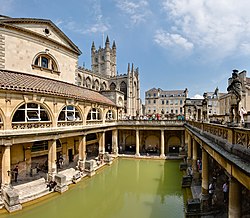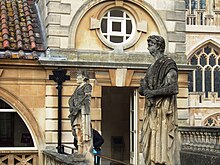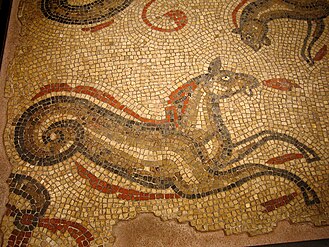| The Roman Baths | |
|---|---|
 The Roman Baths in the city of Bath, England The Roman Baths in the city of Bath, England | |
 | |
| General information | |
| Town or city | Bath |
| Country | England |
| Coordinates | 51°22′51″N 2°21′34″W / 51.3809°N 2.3595°W / 51.3809; -2.3595 |
| Construction started | Baths – 1st century Building – 1894 |
| Completed | 1897 |
| Design and construction | |
| Architect(s) | John Brydon (museum building) |
The Roman Baths are well-preserved thermae in the city of Bath, Somerset, England. A temple was constructed on the site between 60 and 70 AD in the first few decades of Roman Britain. Its presence led to the development of the small Roman urban settlement known as Aquae Sulis around the site. The Roman baths—designed for public bathing—were used until the end of Roman rule in Britain in the 5th century AD. According to the Anglo-Saxon Chronicle, the original Roman baths were in ruins a century later. The area around the natural springs was redeveloped several times during the Early and Late Middle Ages.
The Roman Baths are preserved in four main features: the Sacred Spring, the Roman Temple, the Roman Bath House, and a museum which holds artefacts from Aquae Sulis. However, all buildings at street level date from the 19th century. It is a major tourist attraction in the UK, and together with the Grand Pump Room, receives more than 1.3 million visitors annually. Visitors can tour the baths and museum but cannot enter the water.
Hot spring
The water is sourced from rainfall on the nearby Mendip Hills, which then percolates down through limestone aquifers to a depth of between 2,700 and 4,300 metres (8,900 and 14,100 ft). Geothermal energy raises the water temperature here to between 69 and 96 °C (156.2 and 204.8 °F). Under pressure, the heated water rises along fissures and faults in the limestone, until it bubbles up from the ground into the baths. This process is similar to an enhanced geothermal system, which also makes use of the high pressures and temperatures below the Earth's crust. Hot water at a temperature of 46 °C (114.8 °F) rises here at the rate of 1,170,000 litres (257,364 imp gal) every day, from a geological fault (the Pennyquick fault). In 1982 a new spa water bore-hole was sunk, providing a clean and safe supply of spa water for drinking in the Pump Room.
Water quality
Bath was charged with responsibility for the hot springs in a Royal Charter of 1591 granted by Elizabeth I. This duty has now passed to Bath and North East Somerset Council, who monitor pressure, temperature and flow rates. The thermal waters contain sodium, calcium, chloride and sulphate ions in high concentrations.
The Roman Baths are no longer used for bathing. In October 1978, a young girl swimming in the restored Roman Bath with the Bath Dolphins, a local swimming club, contracted naegleriasis and died, leading to the closure of the bath for several years. Tests showed Naegleria fowleri, a deadly pathogen, in the water. The newly constructed Thermae Bath Spa nearby, and the refurbished Cross Bath, allow modern-day bathers to experience the waters via a series of more recently drilled boreholes.
History

Archaeological evidence indicates that the site of the baths may have been a centre of worship used by Celts; the springs were dedicated to the goddess Sulis, who was locally identified with Minerva. Geoffrey of Monmouth in his largely fictional Historia Regum Britanniae describes how the spring was discovered by the pre-Roman British king Bladud, who built the baths there. Early in the 18th century Geoffrey's obscure legend was given great prominence as a royal endorsement of the waters' qualities, with the embellishment that the spring had cured Bladud and his herd of pigs of leprosy through wallowing in the warm mud.
Roman Britain
The name Sulis continued to be used after the Roman invasion, leading to the town's Roman name of Aquae Sulis ("the waters of Sulis"). The temple was constructed in 60–70 AD and the bathing complex was gradually built up over the next 300 years. During the Roman occupation of Britain, and possibly on the instructions of Emperor Claudius, engineers drove oak piles into the mud to provide a stable foundation and surrounded the spring with an irregular stone chamber lined with lead. In the 2nd century it was enclosed within a wooden barrel-vaulted building, and included the caldarium (hot bath), tepidarium (lukewarm bath), and frigidarium (cold bath). After the Roman withdrawal from Britain in the first decade of the 5th century, these fell into disrepair and were eventually lost due to silting up, and flooding. The Anglo-Saxon Chronicle suggests the original Roman baths were destroyed in the 6th century.
About 130 curse tablets have been found. Many of the curses are related to thefts of clothes whilst the victim was bathing.
Post-Roman use

The baths have been modified on several occasions, including the 12th century, when John of Tours built a curative bath over the King's Spring reservoir, and the 16th century, when the city corporation built a new bath (Queen's Bath) to the south of the spring. Anne of Denmark came to Bath twice for her health. The court physician Théodore de Mayerne bathed Anne of Denmark in the King's Bath on 19 May 1613. She returned in August 1615. Anne of Denmark was surprised by a flame caused by natural gas in King's Bath, and thereafter used the New Bath or Queen's Bath where a column with a crown and the inscription "Anna Regnum Sacrum" was added in her honour.
The spring is now housed in 18th-century buildings, designed by architects John Wood, the Elder and John Wood, the Younger, father and son. Visitors drank the waters in the Grand Pump Room, a Neoclassical salon which remains in use, both for taking the waters and for social functions. Victorian expansion of the baths complex followed the Neoclassical tradition established by the Woods. In 1810, the hot springs were thought to have failed and William Smith opened up the Hot Bath Spring to the bottom, where he found that the spring had not failed but had flowed into a new channel. Smith restored the water to its original course.
The visitor entrance is via an 1897 concert hall by J. M. Brydon. It is an eastward continuation of the Grand Pump Room, with a glass-domed centre and single-storey radiused corner. The Grand Pump Room was begun in 1789 by Thomas Baldwin. He resigned in 1791 and John Palmer continued the scheme through to completion in 1799. The elevation on to Abbey Church Yard has a centre piece of four engaged Corinthian columns with entablatures and pediment. It has been designated by Historic England as a grade I listed building. The north colonnade was also designed by Thomas Baldwin. The south colonnade is similar but had an upper floor added in the late 19th century. The museum and Queen's Bath including the "Bridge" spanning York Street to the City Laundry were by Charles Edward Davis in 1889. It comprises a southward extension to the Grand Pump Room, within which some parts of the 17th-century Queen's Bath remain.
Museum

The museum houses artefacts from the Roman period, including objects that were thrown into the Sacred Spring, presumably as offerings to the goddess. These include more than 12,000 Denarii coins, which is the largest collective votive deposit known from Britain. A gilt bronze head of the goddess Sulis Minerva, which was discovered nearby in 1727, is displayed.
The Bath Roman Temple stood on a podium more than two metres above the surrounding courtyard, approached by a flight of steps. On the approach there were four large, fluted Corinthian columns supporting a frieze and decorated pediment above. The pediment, parts of which are displayed in the museum, is the triangular ornamental section, 26 feet (7.9 m) wide and 8 feet (2.4 m) from the apex to the bottom, above the pillars on the front of the building. It featured the powerful central image of a possible "Gorgon" head glowering down from a height of 15 metres (49 ft) on all who approached the temple.
The great head itself has snakes entwined within its beard, wings above its ears, beetling brows and a heavy moustache. Although there is some disagreement about what this really represents (as Gorgons are usually female), most scholars have converged toward viewing it as a deliberate syncretism of Minerva's Gorgon attribute with the face of a local god who presided over the waters of the nearby sacred spring. The central head has also variously been interpreted as the image of a water god such as Oceanus, or a local Celtic god of the sun. Besides the Gorgon head, the pediment's artistic motif has more recently also been compared to the Jupiter-Ammon clipei found throughout Roman fora and which sometimes depicted local river gods in Celtic provinces.
In early 2010 various stones on the pediment were conserved and rearranged. In 2016, planning permission was received for a new learning centre aimed at schoolchildren and linked to the baths by a tunnel. Funding is being sought from the Heritage Lottery Fund and, if successful, it is hoped the centre will open in 2019.
Preservation

The late 19th century carvings of Roman Emperors and Governors of Roman Britain on the terrace overlooking the Great Bath are particularly susceptible to the effect of acid rain and are protected with a wash of a sacrificial shelter coat every few years. Exhibits within the temple precincts are susceptible to warm air which had the effect of drawing corrosive salts out of the Roman stonework. To help reduce this, a new ventilation system was installed in 2006.
In 2009 a grant of £90,000 was made to Bath and North East Somerset Council to contribute towards the cost of re-developing displays and improving access to the Roman Baths, by the Department for Culture, Media and Sport/Wolfson Fund, which was established to promote improvements in Museums and Galleries in England. Subsequent grants have funded further work on the exhibition design and layout by London-based specialist firm, Event Communications.
Gallery
-
 Spring overflow
Spring overflow
-
 Gorgon head
Gorgon head
-
 Frigidarium (cold pool)
Frigidarium (cold pool)
-
Caldarium. The room uses Roman hypocausts; a floor would have been supported by these structures, where hot air would circulate beneath and heat the room.
-
Model of Roman Bath and Roman Temple of Sulis Minerva as they would have looked at their greatest extent in 4th century AD
-
 Hippocamp mosaic
Hippocamp mosaic
-
 The 'Sacred Pool'
The 'Sacred Pool'
See also
References
- Historic England. "Roman Baths Museum (1394021)". National Heritage List for England. Retrieved 18 December 2018.
- "ALVA - Association of Leading Visitor Attractions". www.alva.org.uk. Retrieved 27 July 2019.
- "Sacred Spring". Roman Baths Museum Web Site. Archived from the original on 2 November 2007. Retrieved 31 October 2007.
- "Hot Water". Roman Baths Museum Web Site. Archived from the original on 4 February 2008. Retrieved 31 October 2007.
- "Bath Hot Springs — Protection and Water Monitoring". Bath and North East Somerset Council. Archived from the original on 27 October 2007. Retrieved 1 November 2007.
- "History of Bath's Spa". Bath Tourism. Retrieved 9 January 2013.
- Crowther, Nigel B. (2007). Sport in Ancient Times. Greenwood Publishing Group. p. 98. ISBN 9780275987398. Retrieved 9 January 2013.
- Kilvington, Simon; Beeching, John (June 1995). "Identification and epidemiological typing of Naegleria fowleri with DNA probes". Applied and Environmental Microbiology. 61 (6): 2071–2078. Bibcode:1995ApEnM..61.2071K. doi:10.1128/AEM.61.6.2071-2078.1995. PMC 167479. PMID 7793928.
- Tindall, Laurence. "Roman Baths King Bladud 1982". Retrieved 25 October 2008.
- ^ "The Roman Baths". Somerset Tourist Guide. Archived from the original on 5 December 2010. Retrieved 1 November 2007.
- Geoffrey of Monmouth (1966). The History of the Kings of Britain. Translated by Thorpe, Lewis. Harmondsworth, England: Penguin. p. 80. ISBN 0-14-044170-0.
- Borsay, Peter (2000). The Image of Georgian Bath, 1700-2000. Oxford, England: Oxford University Press. pp. 49–55. ISBN 0-19-820265-2.
- "City of Bath World Heritage Site Management Plan". Bath and North East Somerset. Archived from the original on 14 June 2007. Retrieved 1 November 2007.
- "The History of Plumbing — Roman and English Legacy". Plumbing World. Archived from the original on 11 November 2007. Retrieved 1 November 2007.
- ^ "The Roman Baths". TimeTravel Britain. Retrieved 1 November 2007.
- "The Roman Baths". BirminghamUk.com. Retrieved 1 November 2007.
- Havinden, Michael (1981). The Somerset Landscape. The making of the English landscape. London: Hodder and Stoughton. p. 67. ISBN 0-340-20116-9.
- Bayley, Stephen (September 2007). "Is Bath Britain's most backward city?". The Observer. Retrieved 1 November 2007.
- Roger Tomlin (1988), Tabellae Sulis: Roman inscribed tablets of tin and lead from the sacred spring at Bath, Oxford.
- ^ "City of Bath World Heritage Site Management Plan — Appendix 3". Bath and North East Somerset Council. Archived from the original on 4 August 2007. Retrieved 1 November 2007.
- Joseph Browne,Theo. Turquet Mayernii Opera medica: Formulae Annae & Mariae (London, 1703), p. 20
- William Shaw & G. Dyfnallt Owen, HMC 77 Viscount De L'Isle Penshurst, vol. 5 (London, 1961), p. 307.
- John Nichols, Progresses of James the First, vol. 2 (London, 1828), pp. 640, 643.
- "William Smith — A brief survey of his work in the Bath". Bath Royal Literary and Scientific Institution. Archived from the original on 13 October 2007. Retrieved 1 November 2007.
- Historic England. "Concert Hall (442115)". Images of England. Archived from the original on 5 February 2009.
- Historic England. "Grand Pump Room (442115)". Images of England. Archived from the original on 5 February 2009.
- Historic England. "North Colonnade at Grand Pump Room (442111)". Images of England. Archived from the original on 10 February 2009.
- Historic England. "South Colonnade at Grand Pump Room (442112)". Images of England. Archived from the original on 7 February 2009.
- Historic England. "Museum & Queen's Bath including "Bridge" spanning York Street to City Laundry (442116)". Images of England. Archived from the original on 10 February 2009.
- "Objects from the spring". Roman Baths Museum Web Site. Archived from the original on 2 November 2007. Retrieved 31 October 2007.
- "Minerva's Head". Roman Baths Museum Web Site. Archived from the original on 2 November 2007. Retrieved 31 October 2007.
- Richmond, I. A.; Toynbee, J. M. C. (1955). "The Temple of Sulis-Minerva at Bath". The Journal of Roman Studies. 45. The Journal of Roman Studies, Vol. 45: 97–105. doi:10.2307/298749. JSTOR 298749. S2CID 162695154.
- "New addition to Gorgon's head". Bath and North East Somerset Council. Archived from the original on 4 December 2007. Retrieved 1 November 2007.
- "The Gorgon's head". Roman Baths Museum Web Site. Archived from the original on 2 November 2007. Retrieved 31 October 2007.
- ^ Cousins, Eleri H (2016). "An Imperial image: the Bath Gorgon in context" (PDF). Britannia. 47: 99–118. doi:10.1017/S0068113X16000131. S2CID 191391802.
- "Key objects of the collection". Roman Baths Museum Web Site. 24 October 2014. Retrieved 9 July 2015.
- "Bath Roman Baths repairs by Minerva". Minerva Stone Conservation. Retrieved 19 January 2010.
- "Planning permission granted for Archway Project at the Roman Baths". The Roman Baths. 14 September 2016. Archived from the original on 18 September 2016. Retrieved 18 September 2016.
- "Roman Baths learning centre planning permission granted". BBC News. 17 September 2016. Retrieved 18 September 2016.
- "Conserving the monument". Roman Baths Museum Web Site. Archived from the original on 7 October 2006. Retrieved 31 October 2007.
- "Temple precinct work complete". Bath and North East Somerset Council. Archived from the original on 3 December 2007. Retrieved 1 November 2007.
- Morris, Steven (10 September 2010). "Bath cleansing brings Romans back to life". Guardian. Retrieved 10 September 2010.
- "DCMS Wolfson Museums and Galleries Improvement Fund A Public Private Partnership (2002 to 2010)" (PDF). The Wolfson Foundation. Archived from the original (PDF) on 11 September 2015. Retrieved 30 November 2017.
- "High Life and Low Life in Roman Britain". Event Communications. 2012. Archived from the original on 5 November 2020. Retrieved 10 October 2019.
- "Interview with Event Communications – East Baths Project". TheRomanBaths. 2017. Archived from the original on 4 November 2020. Retrieved 10 October 2019.
External links
- Official website
- Conservation work within the baths.
- BBC 360 degree panorama
- 360 degree virtual Panomorphic Tour of the museum.
- History of Bath's Spa.
| Roman visitor sites in the UK | ||
|---|---|---|
| Villas |  | |
| Forts & military |
| |
| Towns | ||
| Museums | ||
| Other sites | ||
Categories:
- Ancient Roman baths in England
- Grade I listed buildings in Bath, Somerset
- Grade I listed museum buildings
- Holy wells in England
- Museums in Bath, Somerset
- Museums of ancient Rome in the United Kingdom
- Roman town of Bath
- Roman religious sites in England
- Scheduled monuments in Bath and North East Somerset
- Spas
- Temples of Minerva